Introduction
The fall of Avdiivka on the 17th of February 2024 is one of the more sobering junctures of the Ukrainian-Russian war for both the Ukrainian side and its allies. This defeat did not arrive without warning but was instead expected by both Western observers and the Ukrainian high command which, unlike during the battle for Bakhmut, opted to tactically withdraw its forces to a better position. This article intends not to investigate the circumstances which led to the fall of Avdiivka but will assess some characteristics germane to understanding the situation the Armed Forces of Ukraine (AFU) faced there, before moving onto the role of FPV drones west of Avdiivka.
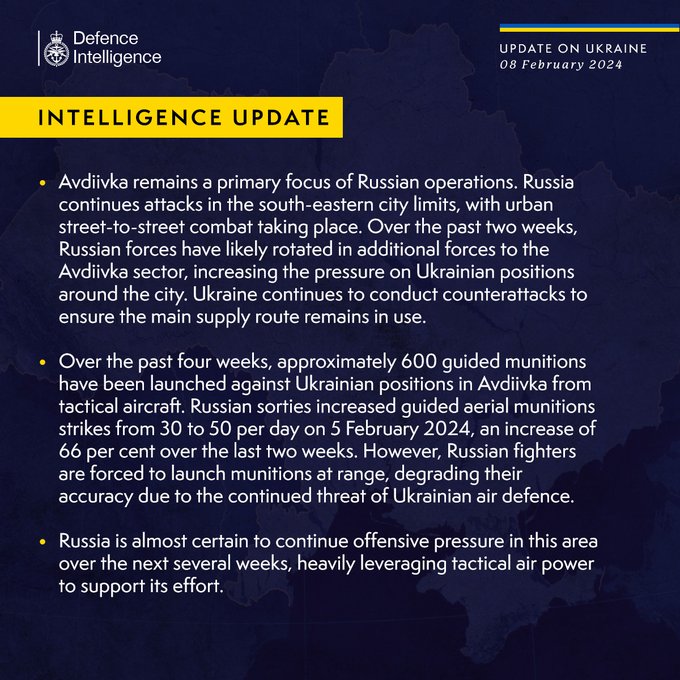
Three crucial factors contributed to the fall of the Avdiivka stronghold. The first was the Russian VKS’s deployment of long-range glide bombs, such as the FAB-500 or the more lethal FAB-1500. These hit and systematically destroyed both the city and its surrounding areas for months, creating significant problems for the AFU’s defending forces. As documented by multiple sources at the time [1], in the first week of February Ukrainian forces were subjected to up to 50 strikes per day [2-3]. The UK Defence Intelligence update published on the 8th of February 2024 (Figure 1) highlighted the scale of Russian airstrikes using guided munitions which amounted to an increase of 66% within two weeks alone [4].
A second, significant issue facing the AFU was the substantial and ever-increasing concentration of Russian manpower, concentrated within three attack vectors around Avdiivka. The resulting pressure this caused on defending forces was compounded by the challenges caused by the AFU’s manpower shortages during its defence of Avdiivka. At this article’s date of publication, Ukrainian forces in the field are still waiting for benefits from the last mobilisation legislation passed from the Rada, aimed at easing currently insufficient levels of manpower [5].
The third, and arguably most significant, factor afflicting the AFU during both the battle of Avdiivka and the AFU’s current challenges along the frontline [6] remains Ukraine’s lack of artillery ammunition. With the delayed US assistance and Europe failing to meet its arms production targets in 2023, Ukrainian forces have been struggling to maintain their frontline positions. Their challenges, within these frontline positions, have been exacerbated by delays in the US Congress in passing the, now urgent, $60 billion military aid package. Shortages of such valuable resources have stretched Ukraine’s ability to fight effectively even further and, with an increase in Russia’s assaults on Avdiivka corresponding to the AFU’s ammunition shortages, indicate a Russian recognition of Ukraine’s deficit during this battle. The fall of Avdiivka is emblematic of Western artillery’s necessity; with any dearth of which handing battlefield advantages to Russia’s forces, which intensified their assaults when Ukraine’s ammunition shortages became apparent.
In the face of challenges such as ammunition shortages, reduced aerial support and a smaller, fatigued ground force, Ukrainian forces have turned to FPV (First Person View) drone production programmes to assist the forces on the frontline. The empirical data shows that these drones are a formidable tool, demonstrating significant value as a weapon system.
FPV drone usage up to 31-03-2024
To explore the progression of FPV drone usage and its impact on the conflict, it is important to understand that the data analyzed within this article is based on geolocated and verified attacks recorded by operators, and released in either edited or unedited versions on Telegram channels. The strikes recorded in this database, despite having been verified and geolocated with extreme care, represent only a portion of all total attacks. Uncertainty regarding data arises from various factors, one of which is the time constraints associated with editing and distributing each strike. However, by analyzing the observed data over an extended period, it is possible to identify trends crucial to understanding this new weapon system and its usage.
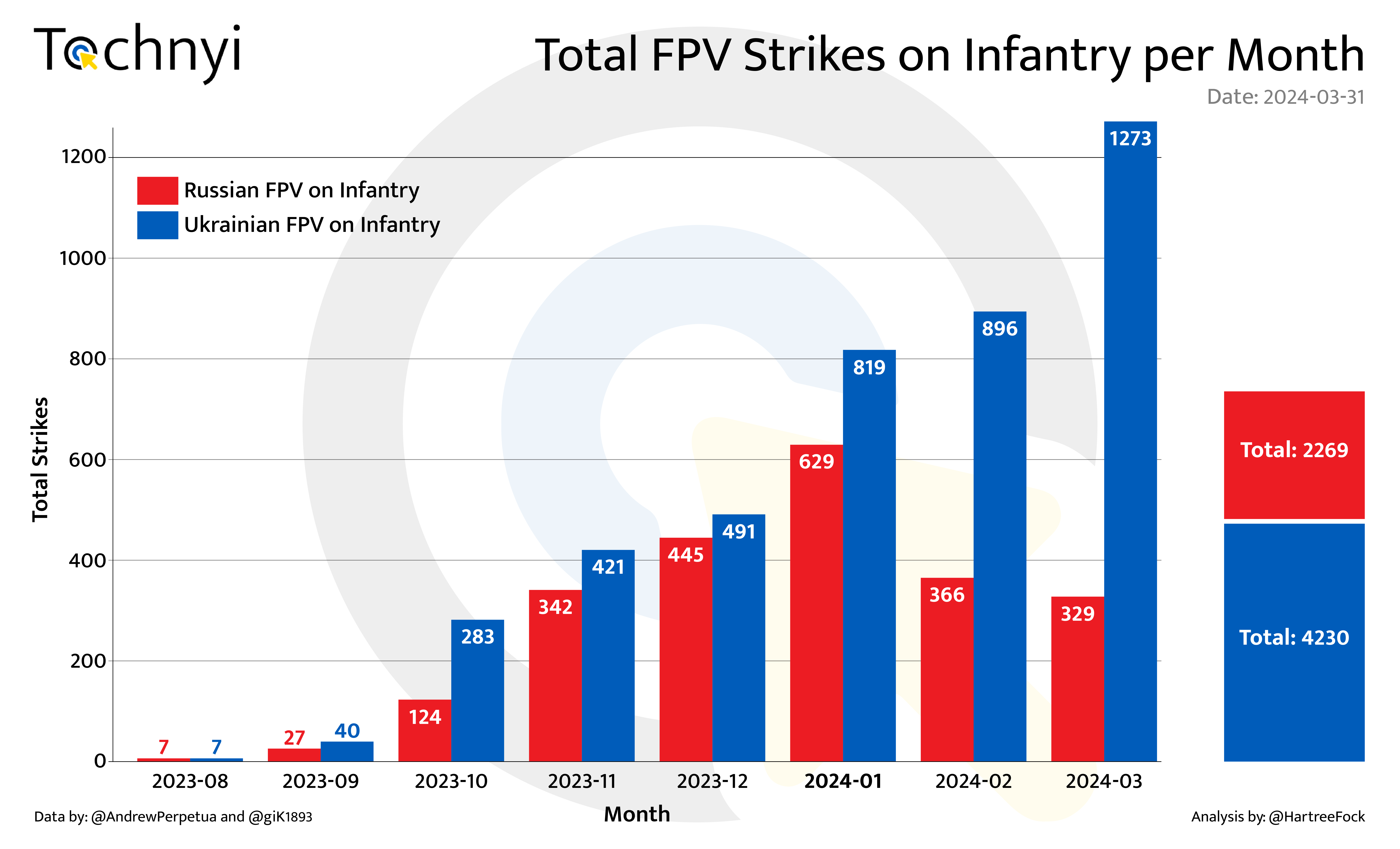
Figure 2 contains the most data up to March 31, 2024. This data has been produced using a Python code that has been developed and continuously improved over time. As a result, some discrepancies may exist in comparison to past data published in other articles or on X.com. Since October 2023, there has been consistent growth in the usage of FPV drones, albeit at varying rates. This, however, changed notably after December 2023, which marked a turning point for the usage of FPV drones in infantry operations [7]. Since then, Ukrainian forces have continued to conduct more strikes than their Russian counterparts. The highest level of usage thus far for Russia has occurred in January 2024, with a steady decline observed thereafter.

The data relating to the daily count of FPV drone strikes on infantry, shown in Figure 3, exhibit clear recent changes. Remaining consistent is the average number of strikes by the Russian forces, with an average of 15 strikes per day being recorded. This stands in marked contrast to the Ukrainian forces, which have managed to achieve an average of nearly 40 strikes per day, with this gap continuing to grow.
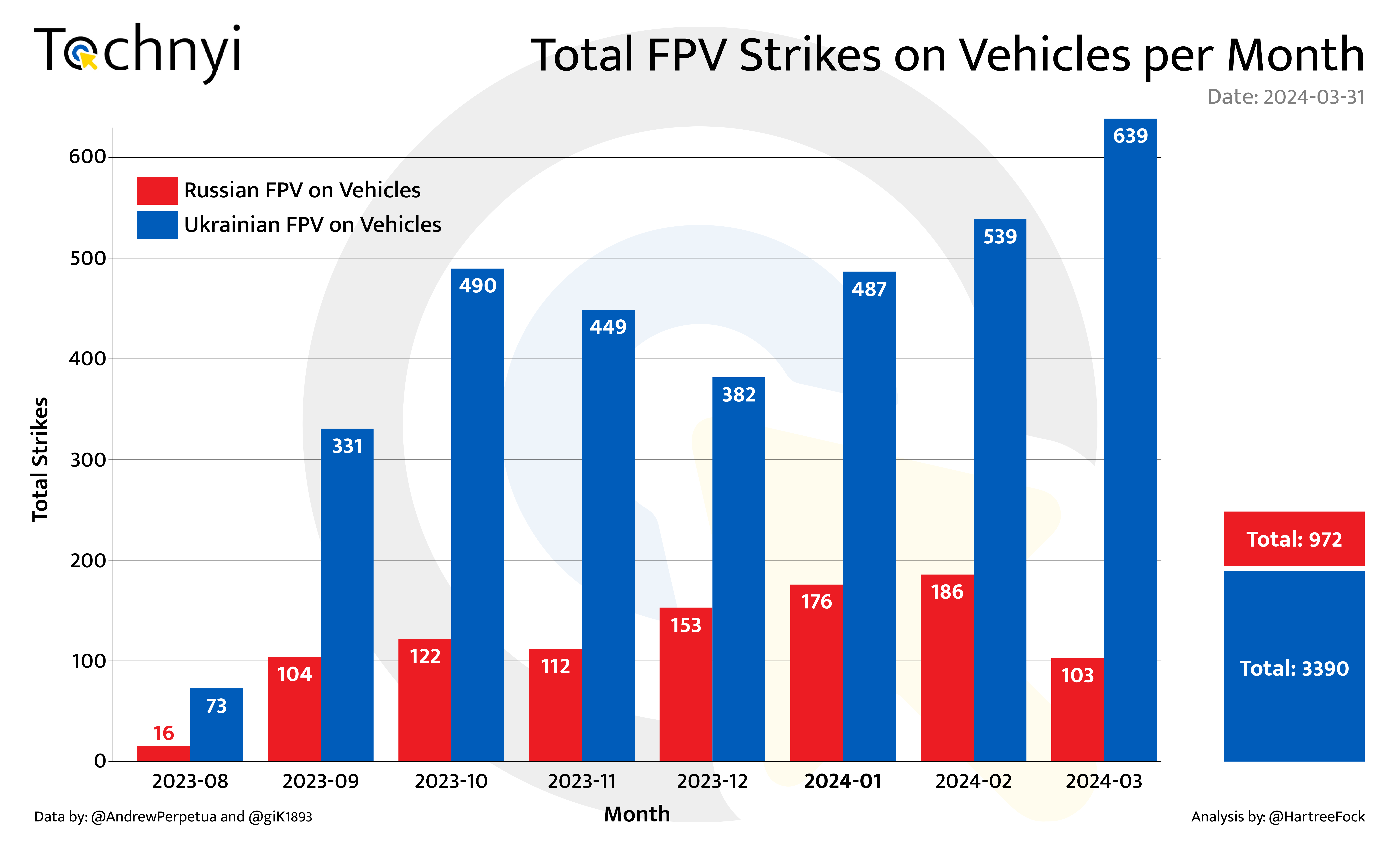
If the situation regarding infantry strikes has seen a significant shift, the situation regarding vehicle strikes has changed similarly. A significant increase in FPV drone strikes on vehicles was observed as shown in Figure 4, with Ukrainian forces striking 229, 311, 353 and 536 more vehicles each month from December to March respectively, reaching an astonishing maximum of 639 hits on vehicles in March alone. Russian forces have not been able to match Ukraine in its number of vehicle strikes per month.
One challenge to this particular data point’s relevance has suggested an extraneousness of Russia’s vehicle losses to FPV drones. Initially was suggested that this phenomenon was correlated to the big difference in the number of vehicles between each side. However, this phenomenon persisted (as shown by the increase/decrease for Russia/Ukraine between December 2023 and March 2024). The AFU, demonstrating an evolution of their use of armour to counter the FPV threat, have been observed avoiding the deployment of large armour columns, a tactic that saw them halted at the start of the 2023 counteroffensive. In contrast, the Russians have continued this strategy of moving forces forward in columns, leaving high-value assets significantly exposed. This notion is also confirmed by independently gathered data from different analysts like Dr Gudmundsson and Mr Vereker [8] showing the constant increase in armoured vehicle losses, not only due to FPV drone strikes.
Both Russia’s and Ukraine’s strategies can be observed in the daily graph shown in Figure 5, of vehicle strikes, in which Russia maintains similar results and records a small, but increasing, gap for Ukraine. Overall, Ukraine continues to use FPV drones as an effective weapon to attrit Russian resources; saving Ukraine’s precious artillery shells in the process for more critical fire missions.
Data regarding strikes on positions in 2024 (Figure 6) have shown a dramatic increase and highlighted Ukraine’s ability to capitalise on its initial successes in the number of strikes that led to an increase in Russian losses. Until February, Russia consistently outperformed Ukraine in this aspect, but a shift began to emerge in February, culminating thus far in the remarkable results of March. This serves as a testament to the collective efforts of volunteers and local drone manufacturers working to deploy as many drones as possible producing parts with also the eld of new technologies. Overall, trenches remain the most frequently targeted positions, confirming their vulnerability due to the widespread use of poor concealment conditions, difficulties in countering drone attacks with EW but also the increase in the type of drones and warheads which makes it very difficult to adapt trenches, especially in an active front, as the previous article in this series examined [9].
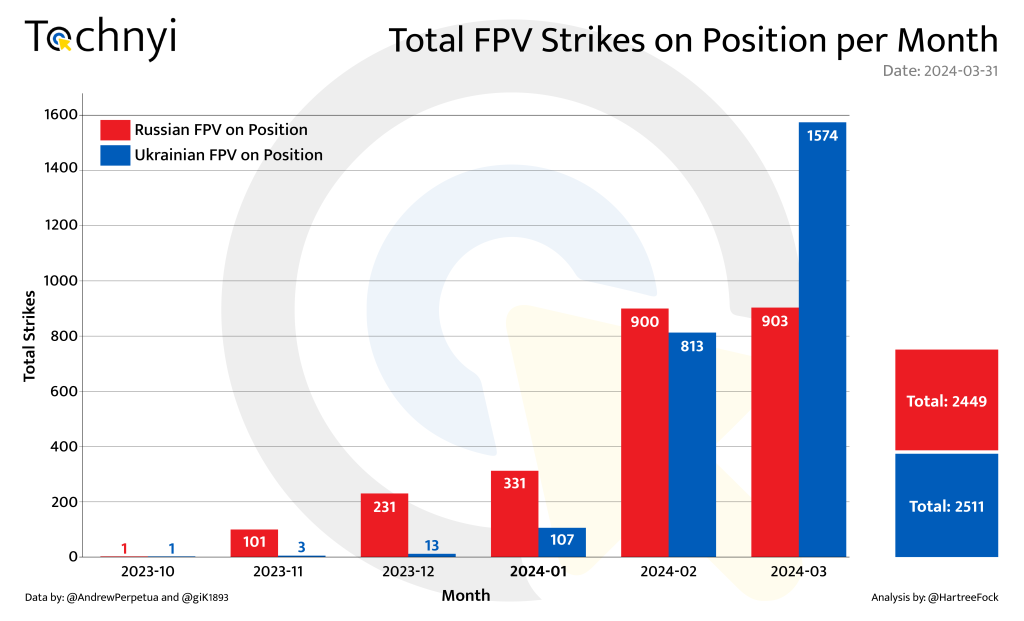
The situation on the ground: Vehicle and defence positions
Two particularly active areas for FPV drone activity will be considered for analysis: Avdiivka, and Chasiv Jar. These locations serve as notable examples of the increasing usage of FPV drones on the Ukrainian battlefield at present. The prevalence of FPV strikes in these locations may also suggest that Electronic Warfare has been less effective or less extensively deployed. Concurrently, each area represents a vulnerable target for Russian forces, who have been conducting a series of offensive operations in recent months in an attempt to capitalize on as many gains as possible before the imminent arrival of artillery shells produced and procured from Western sources. Artillery and cluster munition artillery shells indeed had demonstrated to be effective in hampering Russian manoeuvrability [10].
A trend becomes evident upon analysing the increasing losses of Russian BMPs registered since December 2023, supported by video evidence, satellite imagery, and geolocation data provided by Andrew Perpetua and his team. Figure 7 shows the total loss of BMPs either destroyed, captured or damaged by any means. It is apparent from this data that Russian operations escalated leading to a force more exposed to several threats including FPV drones.
This outcome should not be wholly unexpected. Since the outset of the full-scale invasion, Russians have been observed repeatedly launching large-scale mechanized infantry assaults against Ukrainian defensive lines. With the increased use of cluster munitions and other artillery systems, this tactic has been observed changing to smaller group assaults, such as the Storm-Z seen in Bakhmut [11]. However, in the last few months due to the AFU’s lack of artillery ammunition, Russian forces restarted their large-scale armoured column tactics which ultimately, despite their sheer number of losses, forced the Ukrainian forces to retreat from Avdiivka [12,13].
The use of First Person View (FPV) drones attacking positions, as shown in Figure 6, has been noted to have significantly changed the ground situation. The graph above illustrates the data collected and verified through geolocation and analysis of open-source videos. From January to February 2024, Russia increased the number of its FPV drone attacks on Ukrainian positions. This strategy was particularly effective in denying the defenders the ability to hold their positions, especially during urban fighting in both Marinka and later in Avdiivka, as demonstrated in a previous article. However, Ukrainian forces quickly responded and achieved a certain level of parity in February. Remarkable in this regard is the number of strikes registered in March, with Ukraine recording 1574 strikes against Russian positions, while Russia maintained a high level of strikes, 903 in total. It is worth noting that not all such strikes were successful, especially when well-prepared defences were attacked. Nonetheless, this information reflects the ground situation.
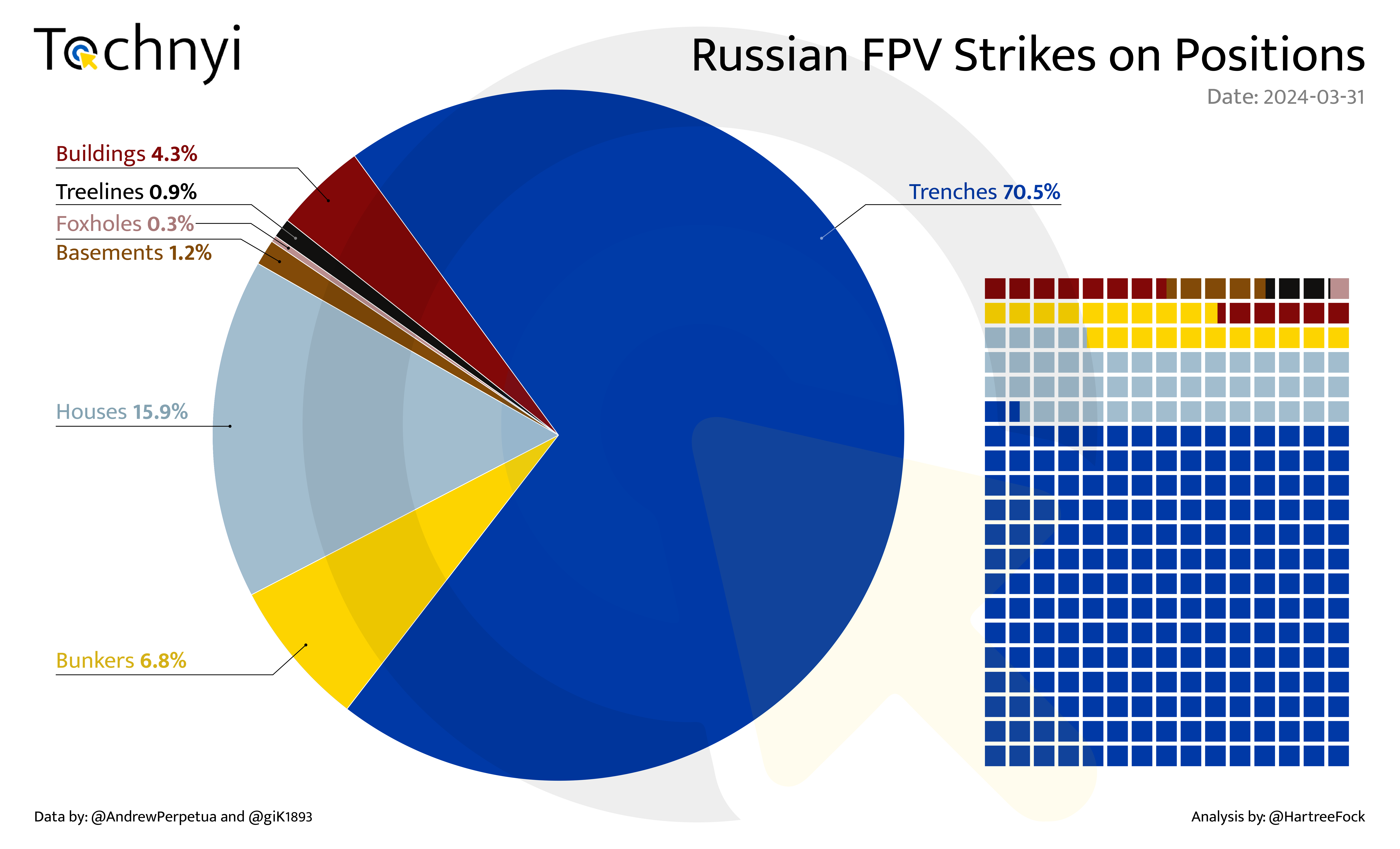
In any analysis of strikes on positions, it is important to understand where most of the Russian FPV drone strikes have occurred. Figure 8 shows an overall 70.5% of all the strikes have targeted trenches. As previously analyzed, the precision of FPV drone strikes poses a significant threat to defensive lines, especially when exposed to unchallenged aerial reconnaissance performed by surveillance drones using thermal vision. Houses are the second most struck target and become even more vulnerable when Russian ground forces move their offensive operations into towns.
The situation on the ground: Avdiivka
To gain a clear understanding of the effective use of FPV drones from the Ukrainian side it is crucial to have a clear picture of the offensive manoeuvres of the opposing side and Avdiivka is one of the areas where the highest concentration of FPV strikes have been recorded and geolocated. The map shown below is based on several open-source intelligence analyses, in addition to data compiled and corroborated by researchers such as Poulet [14], who on X.com has posted near-daily updates of the ground operations within the most active areas of the frontline.
When we superimpose the map created by Poulet and the data of Ukrainian FPV drone strikes (represented by blue stars in Figure 9), we can get a better understanding of the importance of the directions where Russian forces attempted to push the Ukrainian lines forward – the Stepove-Berdychi direction and the Lastochkyne-Orlivka direction. Going south, there are two more vectors, from Tonenke and lastly towards Pervomaiske in the defense of Avdiivka’s western areas.
Most of the geolocated strikes are concentrated around the Stepove-Berdychi direction and along the Lastochkyne-Orlivka axis. The strikes are distributed on main roads that the Russians have used to cross open terrain quickly, especially in the Stepove-Berdychi direction. However, the strikes were not only aimed at roads close to the frontline but also in its rear areas. Of particular interest is the strike strategy adopted by the Ukrainians in the Lastochkyne-Orlivka direction (Figure 10).
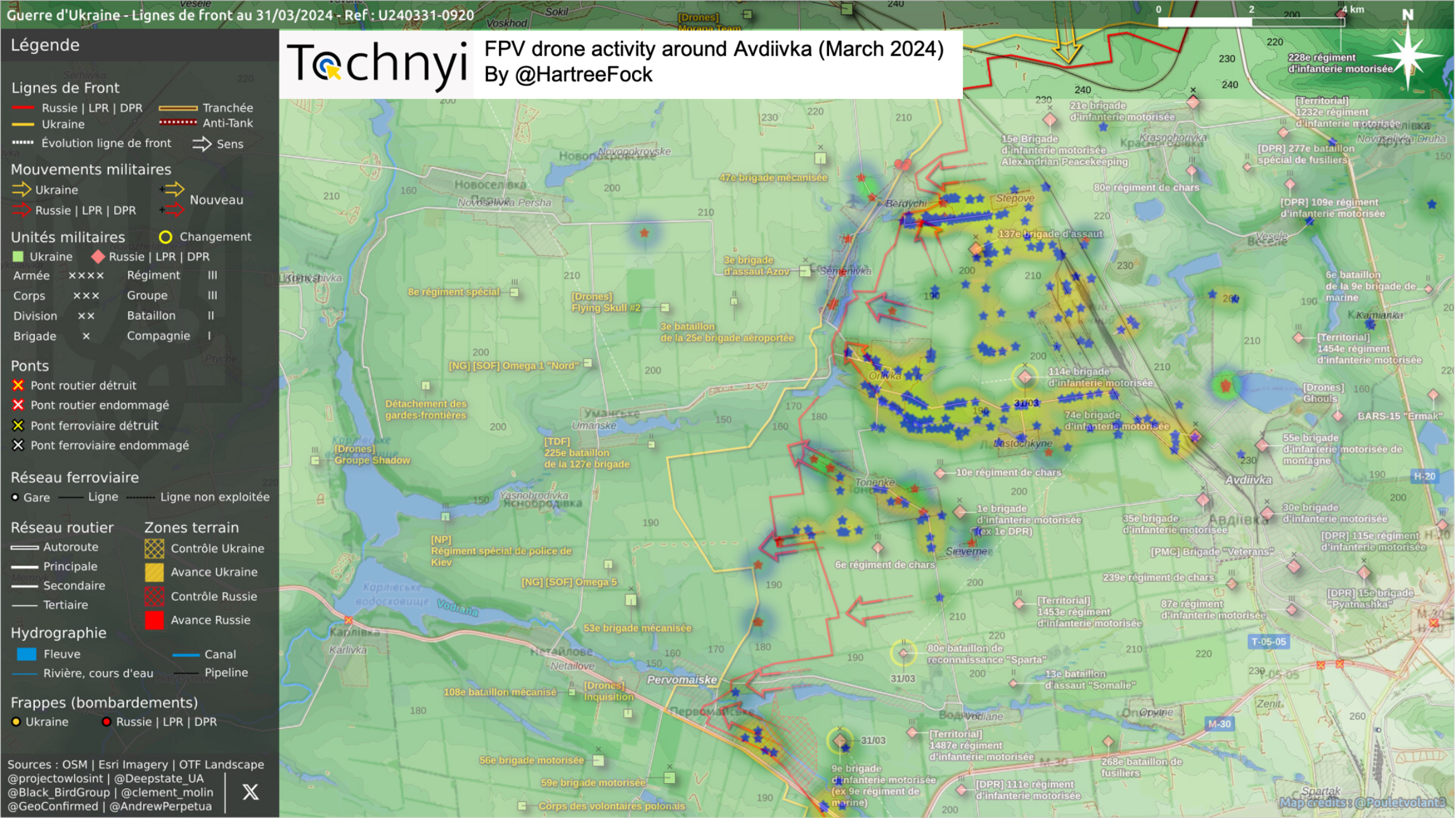
The use of FPV drones has been of particular intensity along attack routes and main supply routes, as well as tree-line positions away from roads where troops were on rotation and reconstituting. This, combined with relentless strikes to the Russian rear areas, has contributed to blocking and delaying Russian advances. Consequently, this has also allowed Ukrainian troops to reorganize their defensive lines. A comparatively flat terrain and inherent absence of cover, and the Russian troops’ need to use their numerically superior advantages to retain momentum have made it easier for Ukrainian FPV drones to inflict severe casualties. This has forced the Russians to intensify aerial bombing campaigns to destroy or deny AFU defenders their positions.
Technological development: Night Vision and thermal race
Another area where significant changes have occurred is night vision usage in FPV drones, shown in Figure 11. This constitutes a significant development and, as the collected data shows, Russian FPV drones with night vision capabilities have had considerable success since their introduction in November 2023, with no apparent recorded response from Ukrainian forces.
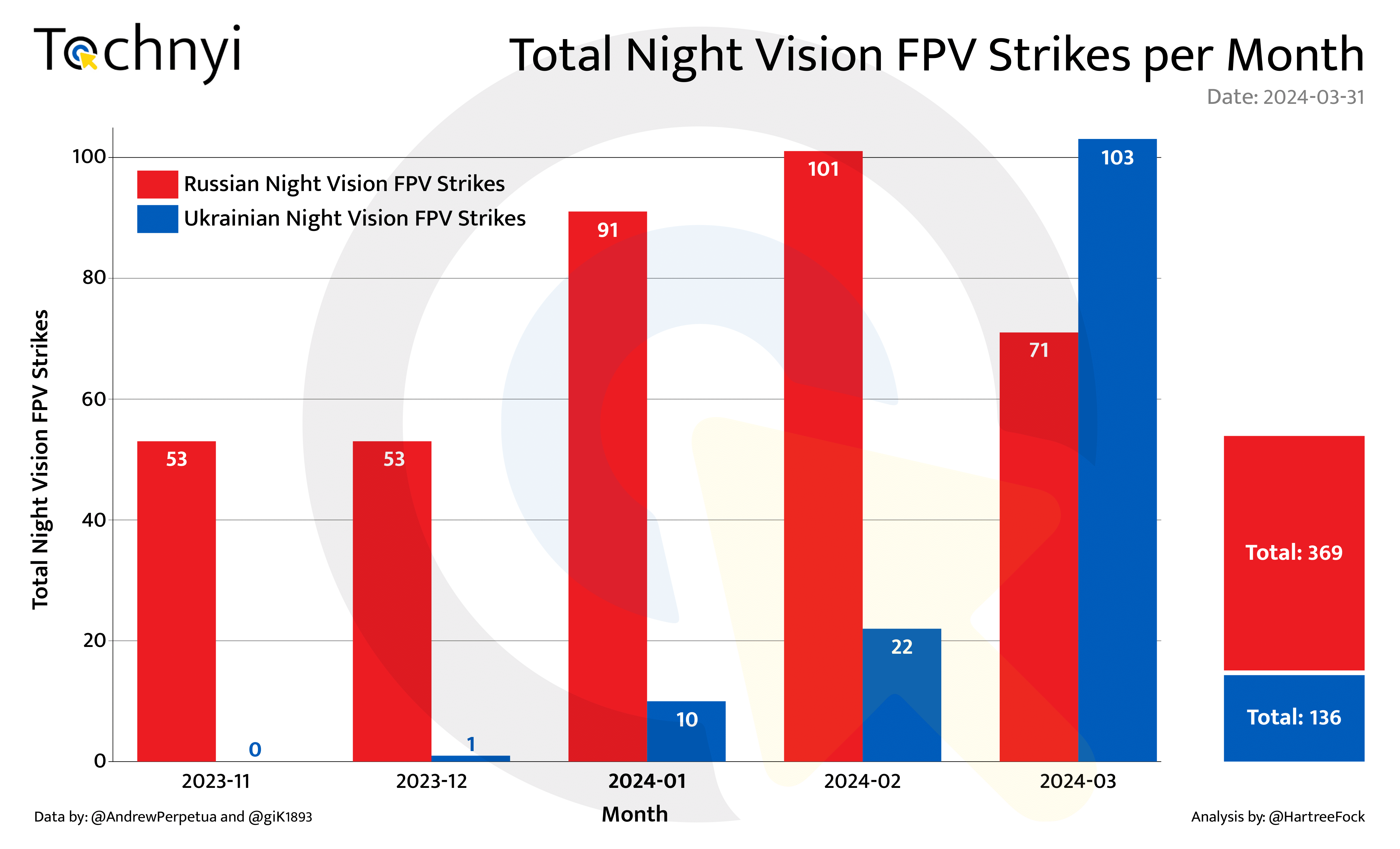
Significant changes occurred over the last three months, marked by exponential growth in March 2024. Such rapid expansion may be attributed partially to drone operators reporting their nighttime operations more frequently, although this alone cannot fully justify the surge recorded. One of the primary challenges in deploying night vision devices is the cost of the optical components, often a thermal sensor. While a basic FPV drone typically costs around $300 to $400, incorporating a more sophisticated thermal sensor can significantly escalate the price to over $1,000. The complexity of integrating a thermal sensor into such a confined and weight-constrained device contributes to this increased cost [15].
To provide context, thermal cameras, also known as infrared cameras or thermographic cameras, are pivotal devices enabling recognition of the heat emitted by objects as infrared radiation. The microbolometer acts as a critical component in thermal cameras. All objects with a temperature above absolute zero emit infrared radiation, and its intensity is directly proportional to the power four object’s temperature, marking the initial step in thermal imaging. Optics play a crucial role in directing infrared radiation onto the sensor. The lens of the thermal camera focuses incoming infrared radiation onto the microbolometer array. Comprising numerous individual pixels, often numbering in the thousands or even millions, the microbolometer is a tiny yet sophisticated sensor. Each pixel in the microbolometer array contains a series of miniaturized resistors. When infrared radiation strikes these resistors, they change electrical resistance, directly proportional to the intensity of the received radiation.
The microbolometer’s remarkable sensitivity and precision render it indispensable in thermal imaging technology and often represent the most critical and expensive component. Their cost and the difficulties involved in acquiring them pose a real bottleneck in thermal FPV drones. However, this challenge has been addressed by Ukrainian volunteer groups such as the Wild Hornet, who have adopted general-purpose infrared bolometers [16], which are widely available and are an order of magnitude cheaper than specialized microbolometers. Infrared cameras, covering a broader range of applications, offer models at various levels of complexity, resulting in a broader spectrum of financial expenses. For basic low-light functionality, an effective IR camera is more affordable, especially when intended for use on loitering munitions.
Technological development: FPV drones warheads
One of the most significant progress in the development and specialization of FPV Drones is the production and use of dedicated warheads. The evolution of FPV drones has been propelled by the need to innovate swiftly, utilizing relatively scarce resources, in real-time adaptability to battlefield demands. Such an effort has been accelerated, as mentioned earlier, by the dire situation of the AFU’s artillery ammunition resources to date. Traditional drones have primarily been used for reconnaissance and surveillance purposes, providing valuable intelligence to military forces. These types of drones have also seen increasing application in bombardment using repurposed munitions, such as 30 and 40-mm grenades, usually retrofitted with tail wings to give stability, or, in some cases more sophisticated ammunition developed to deliver maximal damage to soft targets [17].
The introduction of FPV drones more offensive missions have been conducted by the drone pilots of both sides. In particular, FPV drones with their agility and speed have allowed pilots to hit moving targets but also well concealed targets. Initial use of FPV relies on traditional warheads repurposed to the scope, among the RPG-7 anti-tank grenade.
A recent article from Forbes [18] shed light on the impact of FPV drones in modern warfare. It highlighted the effectiveness of airburst shrapnel warheads in revolutionizing drone warfare. These warheads, capable of detonating mid-air to unleash a barrage of lethal projectiles, have proven to be highly effective against both personnel.
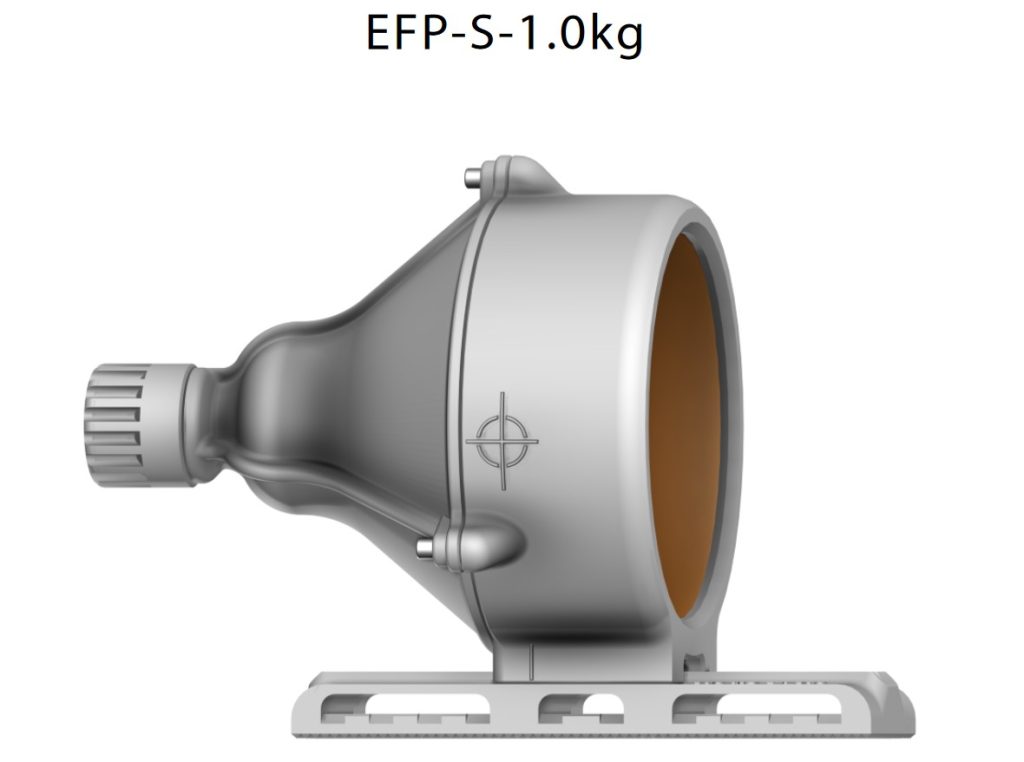
The article [18] dives into the technological advancements that have enabled FPV drones to wield such devastating firepower. This directional capability demonstrated widely its effectiveness showing the drones’ effectiveness in engaging dispersed enemy forces, offering military commanders greater flexibility in combat operations. Similar analysis and observation were reported in another article from Forbes, written by David Hambling [19]. In this case, particular emphasis is made on the use of multiple FPV drones with Claymore-like munition capable of striking with shrapnel a precise rectangular area, making it nearly impossible for the infantry to take cover. FPV drones with airburst shrapnel warheads have the potential to transform tactics allowing them to engage targets with unparalleled precision and lethality. By leveraging this technology, military forces can neutralize enemy threats with surgical precision while minimising collateral damage.
Ukraine has been at the forefront of developing advanced armour-piercing ammunition for FPV drones, as reported by Defence-UA [20]. The country’s innovative approach to drone warfare has resulted in the creation of highly effective Explosively Formed Penetrator (EFP) shells (Figure 12), capable of piercing armoured targets. This development represents a significant leap forward in the realm of anti-armour warfare, empowering drones to engage armoured vehicles with unprecedented effectiveness.
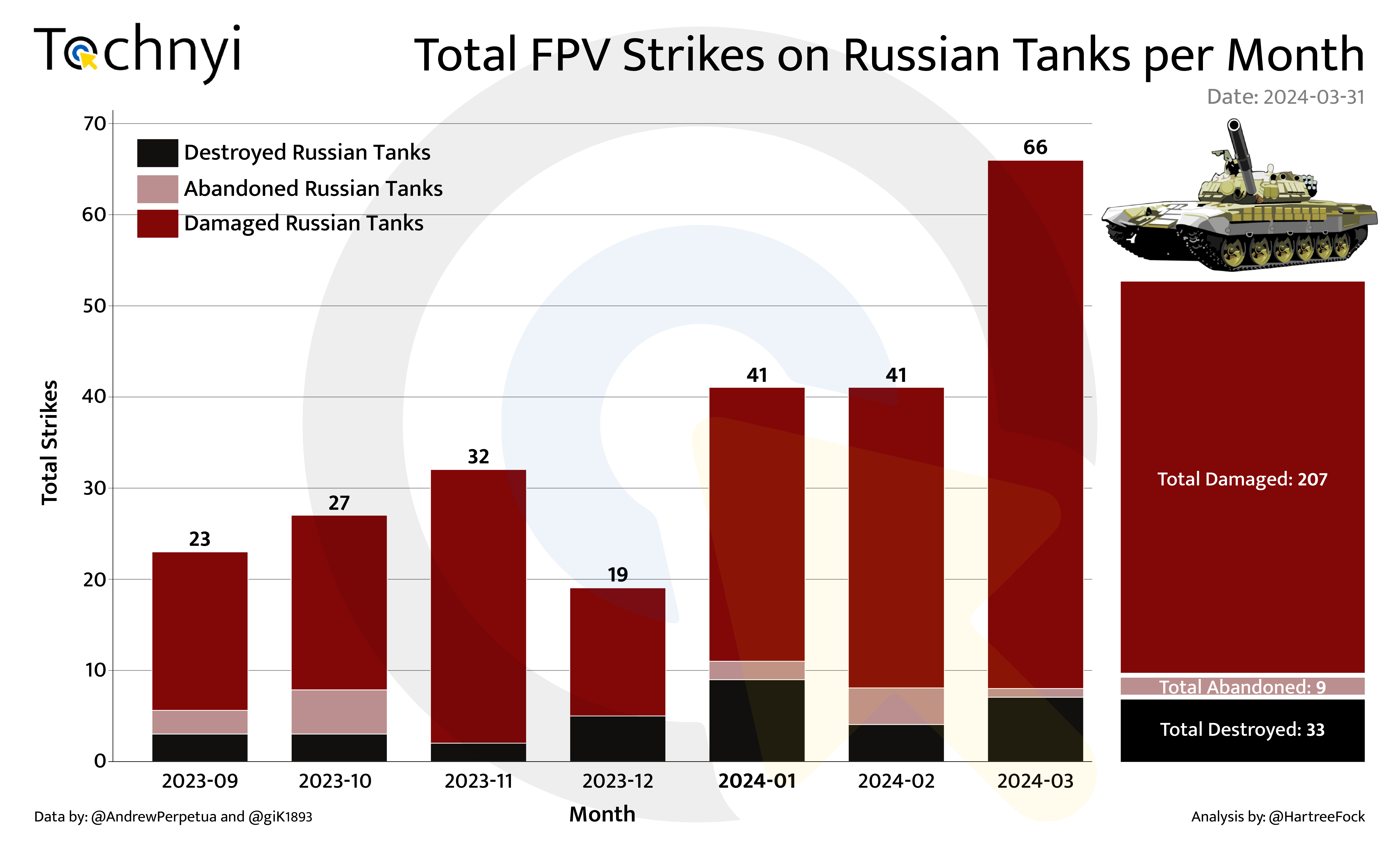
FPV drone strikes have resulted in an effective means to destroy or damage Russian tanks, undermining the armoured doctrine of the Russian army on the battlefield. With their ability to deliver precise strikes against armoured targets, FPV drones equipped with anti-armour warheads have emerged as a potent deterrent against conventional ground forces. The analysis of the visual evidence is very well summarised in Figure 13 where the data on FPV strikes on tanks is reported per total hits, damaged, destroyed and abandoned. Of the 249 visually identified strikes on tanks, 83% are classified as vehicles being damaged, 13% of the strikes are classified as destroyed vehicles and the remaining abandoned/captured. It is worth noting that the trend follows well the data shown regarding the overall FPV drone usage, with the characteristic drop in December 2023.
An even more severe toll is observable in Figure 14 on all BMP types, where a total of 727 visually confirmed strikes. Among them, 57% of the strikes resulted in a clear vehicle loss due to damage, 27% led to the destruction of the vehicle and the remanent strikes led to abandon or capture of the vehicle. The increasing number of IFVs destroyed is a clear signal of the offensive doctrine adopted by the Russian forces in the early stage of the new year.
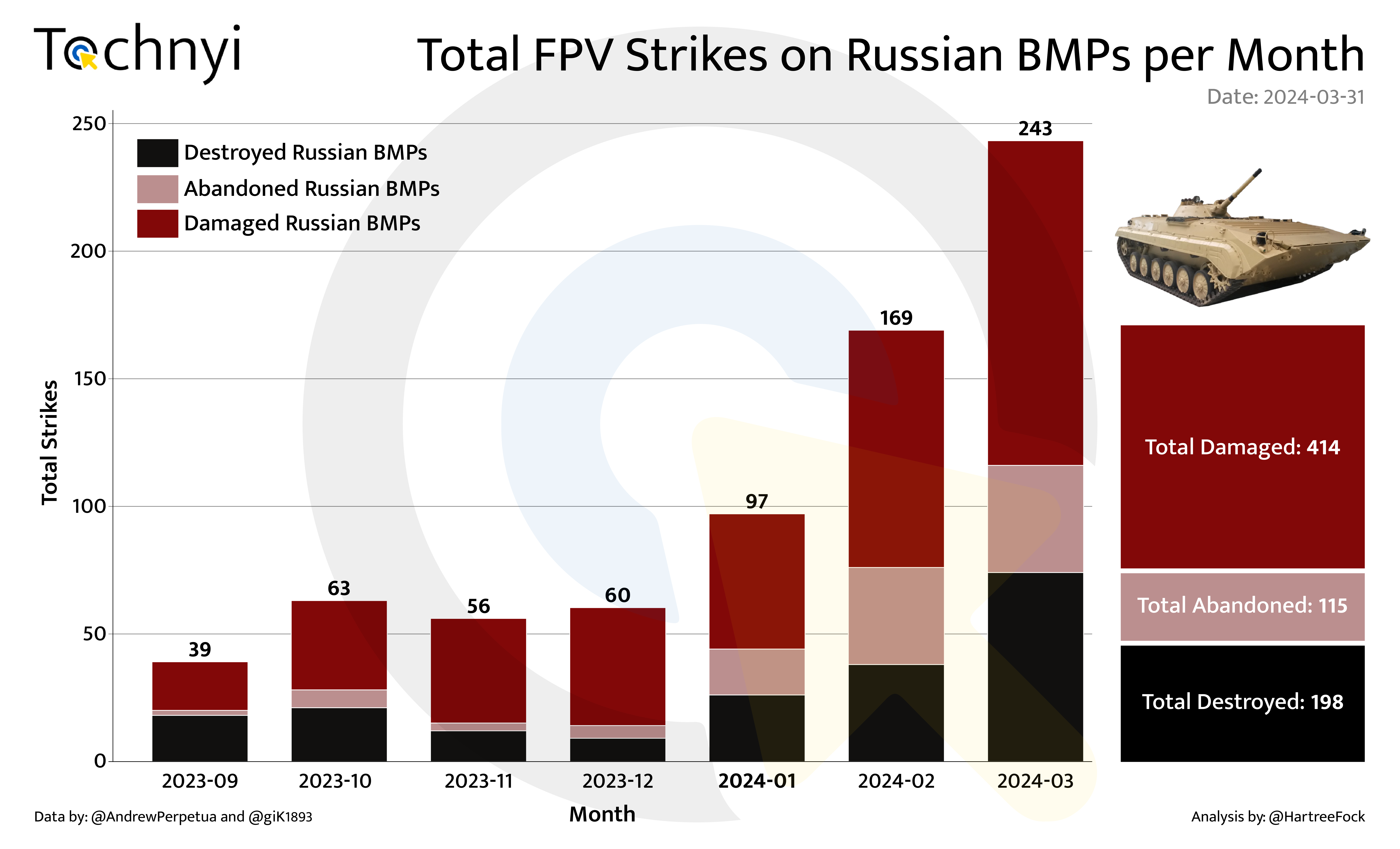
The integration of FPV drones with advanced warheads represents a paradigm shift in modern warfare, offering military forces unprecedented capabilities on the battlefield. As these weapon systems continue to evolve, they are likely to play an increasingly prominent role in shaping the outcome of conflicts around the world. From precision strikes against armoured vehicles to decimating enemy infantry formations, at a relatively low cost, FPV drones are taking a significant share in the panorama of warfare of the 21st century.
Acknowledgment
I would like to express my gratitude to two members of Tochnyi who provided immense support for the work presented here. Firstly, I would like to thank Jonathan for his meticulous proofreading work, and secondly, Chris for his incredible effort in producing the best graphics ever presented in an article on Tochnyi.
References
[1]ISW: Russia show signs of localised air superiority in Ukraine for first time (Last Access 21-04-2024)
[2]Avdiivka defenders subjected to dramatic increase in Russian air strikes over past two weeks (Last Access 21-04-2024)
[3]Governor: Russia carries out 250 air strikes on Avdiivka in 2 weeks
[5] Ukrainian Parliament Passes New Mobilization Law
[6] Congressional Research Service, Ukrainian Military Performance and Outlook, CRS Report Link (Last Access 18-04-2024)
[7] US Defense News, How Ukrainian FPV Drones Destroy Russian Infantry Columns on Avdiivka Front Line, https://www.youtube.com/watch?v=e33vpIEqg6E (Last Access 18-04-2024)
[8] Tank losses verified by Warspotting
[9] Trench warfare in FPV drone era: an analysis
[10] Cluster Munitions Have Changed the Course of the Ukraine War
[12] The Russian Army Just Launched The Biggest Tank Assault Of The War
[14] Guerre d’Ukraine | 31/03/24, @Pouletvolant3, X.com
[15] Video Shows Nighttime Attacks by Ukrainian FPV Drones on Russian Tank and Positions
[16] Tochnyi talks – Wild hornets, live from Ukraine
[17] Steel Hornets: Inside Ukraine’s Amazon For Drone Bombs
[18]A Tiny Drone With A Directional Airburst Warhead Could Mow Down Enemy Infantry In A 60-Degree Arc
[19]Ukraine’s Flying Claymore Mines Cut Down Russian Infantry
[20]Ukraine Developed Advanced EFP-S Armor-Piercing Ammunition for FPV Drones